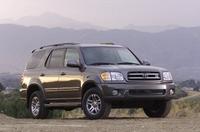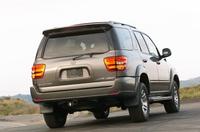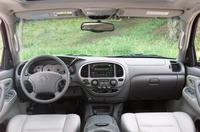New Car Review: 2004 Toyota Sequoia Limited 4x4
DRIVING DOWN THE ROAD
WITH CAREY RUSS
2004 Toyota Sequoia Limited 4x4
A few years ago, Toyota faced a problem. Its flagship SUV, the Land Cruiser, had moved so far upscale that a hole big enough to drive a full-sized sport-utility through was left in the company's lineup. And so the Sequoia was born, and was introduced for the 2001 model year.
As usual, Toyota did its homework when developing the Sequoia expressly for the American SUV market. Americans want interior space and versatility, but not at the expense of comfort and refinement. And, perhaps, while size matters, it is possible to for a vehicle to be too big, especially for the urban and suburban buyers who dominate the SUV customer base.
So the Sequoia was sized to compete with domestic-label regular-wheelbase sport-utes, for the ease in maneuverability and parkability important to its mostly urban and suburban target buyers. Developing the Sequoia from the Tundra full-sized pickup helped keep it affordable, and replacing the truck's leaf-sprung rear axle with a sophisticated multilink and coil-spring suspension made it more civilized.
The engine was and continues to be Toyota's 4.7-liter, 240-horsepower ``iForce'' V8, matched to a four-speed automatic transmission, with a choice of rear- or four-wheel drive. Two trim levels, SR5 and Limited, were originally offered, and continue. Actually, little about the Sequoia has changed since its debut. That's not surprising - Toyota got it absolutely right the first time, with a great combination of space, comfort, and interior versatility at a price far less than the Land Cruiser. And the lack of change is somehow appropriate. The Sequoia redwood trees for which the vehicle is named are hardy and long-lived, and are very little different from their ancestors which lived over one hundred million years ago.
I first drove a Sequoia when it was introduced to the press four years ago. I drove it from the San Francisco area to, appropriately, a location near a redwood grove just outside of Yosemite National Park, and then had the opportunity to drive it on nearby dirt forest roads. It was an excellent vehicle for all phases of the trip, from superslab highways to twisting mountain roads to the logging roads of the National Forest. I've just finished a week with a 4x4 Limited in the less-scenic surroundings of home, and it worked just as well in my more confined small-town environment as it did in the woods.
APPEARANCE: Conservative style wears well, whether in clothing or vehicles. If the Sequoia broke no new stylistic ground when it was introduced, it has aged well. Buyers won't look at it, long before it's paid off, and wonder just what they were thinking, stylewise. The Sequoia is a basic two-box sport-utility with rounded contours. Body-colored plastic bumper caps and wheel arch trim, and twin chromed horizontal bars in the upside-down trapezoid grille help give the Limited model a look that is upscale yet unostentatious.
COMFORT: Space, comfort, and versatility are the strong points of an SUV, and the Sequoia illustrates all very well. It has more interior space than all but the largest extended-wheelbase competitors, and makes good use of that space. Like the exterior, interior styling is more functional than flashy, but hey, it's a daily transportation vehicle, not a science-fiction movie set.
Someone from the minivan department must have been involved in interior design - there are 10 cupholders for eight passengers, with four in the front. Instruments and controls are functional and well-placed. Three rows of seats are standard, with comfy captain's chairs in front, a 60/40 bench in the middle, and a 50/50 bench in the rear offering real space for up to eight adults. (Ok, it helps to be under 5-10 in the rear, but that's better than in many kid-only third rows.) Each side of the rear seat can be folded or removed separately, and each part of the second row can be tumbled forward for access to the rear or to maximize cargo storage. Seatbacks of both rows are adjustable for angle. Liftover is moderate, easing the job of moving heavy pieces of cargo.
The climate control system for both trim levels is dual-zone, with the rear zone adjustable from the second row. The SR5 is well-equipped, and the Limited adds leather for all seats, privacy glass, a tilt-and-slide moonroof, and a good JBL 10-speaker AM/FM/cassette/CD audio system. An in-dash CD changer is available, as is a rear-seat DVD entertainment system.
SAFETY: Four-wheel antilock vented disc brakes are standard equipment, as is the Vehicle Stability Control system and traction control on all driving wheels. Side and side curtain airbags are available.
ROADABILITY: There is no denying that a Sequoia is a truck. And it's built like a truck, too, with body-on-frame construction and a solid rear axle. If this sounds potentially noisy and uncomfortable, forget that notion. The Sequoia shows just how good a well-designed and built truck can be on the road. The steering effort is light, but not too light, with engine-speed sensitive assist. The turning circle is small for the Sequoia's size, making parking easy. The high seating position gives good visibility.
On good pavement, the Sequoia rides as smoothly and comfortably as a luxury car. On bumpier surfaces, there is no hiding the unsprung weight of the large, heavy wheels and tires, but good damping and a five-link mounting system with coil springs tames the live rear axle, and the large truck tires add a measure of air damping. A fully-boxed frame gives it great rigidity, improving both the handling and ride comfort.
With 10.6 inches of clearance in 4x4 trim, and steel skid plates under the front of the engine, transfer case, and fuel tank, it's as capable as a Land Cruiser off the paved highway. Don't try that in a luxury wagon.
PERFORMANCE: The Sequoia is not the biggest vehicle in its class, nor is it the most powerful. But how much size and power do you really need? It more than makes up for any perceived deficiency in macho power with refinement. Its twin-cam ``iForce'' V8 has plenty of strength. It gives the Sequoia a ULEV emissions rating from the EPA, and is smooth and quiet enough to sound and feel more like a luxury engine than a truck motor. With 240 horsepower (at 4800 rpm) and 315 lb-ft of torque (at 3400 rpm), driving through a four-speed automatic transmission, it gets the job, any necessary job, done without fuss or noise. Towing capacity is a healthy 6,500 lbs.
CONCLUSIONS: The Sequoia, Toyota's largest SUV, is an admirable vehicle for use as a family wagon or for back-of-beyond exploration.
SPECIFICATIONS: 2004 Toyota Sequoia Limited 4x4
Base Price $ 44,220
Price As Tested $ 46,226
Engine Type dual
overhead cam 32-valve V8
Engine Size 4.7 liters / 285 cu. in.
Horsepower 240 @ 4800 rpm
Torque (lb-ft) 315 @ 3400 rpm
Transmission 4-speed electronically-controlled automatic
Wheelbase / Length 118.1 in. / 203.9 in.
Curb Weight 5,295 lbs.
Pounds Per Horsepower 22.1
Fuel Capacity 26.1 gal.
Fuel
Requirement 87-octane unleaded regular gasoline
Tires P265/65
SR17 Bridgestone Dueler H/T
Brakes, front/rear vented disc /
vented disc,antilock, brake assist and traction control
standard
Suspension, front/rear independent double wishbone
with coil springs / live axle with 5-link location and coil
springs
Ground clearance 10.6 in.
Drivetrain front engine,
on-demand four-wheel drive
PERFORMANCE
EPA Fuel Economy - miles per gallon city /
highway / observed 14 / 17 / 15
0 to 60 mph (est) 9.0 sec
Towing capacity 6,500 lbs.
OPTIONS AND CHARGES
In-dash 6-disc CD changer $ 200
Driver and front passenger side airbags $ 500
Rear load-leveling suspension $ 360
Carpeted floor mats and door sill protector $258
Glass breakage sensor $ 158
Delivery charge $ 149





